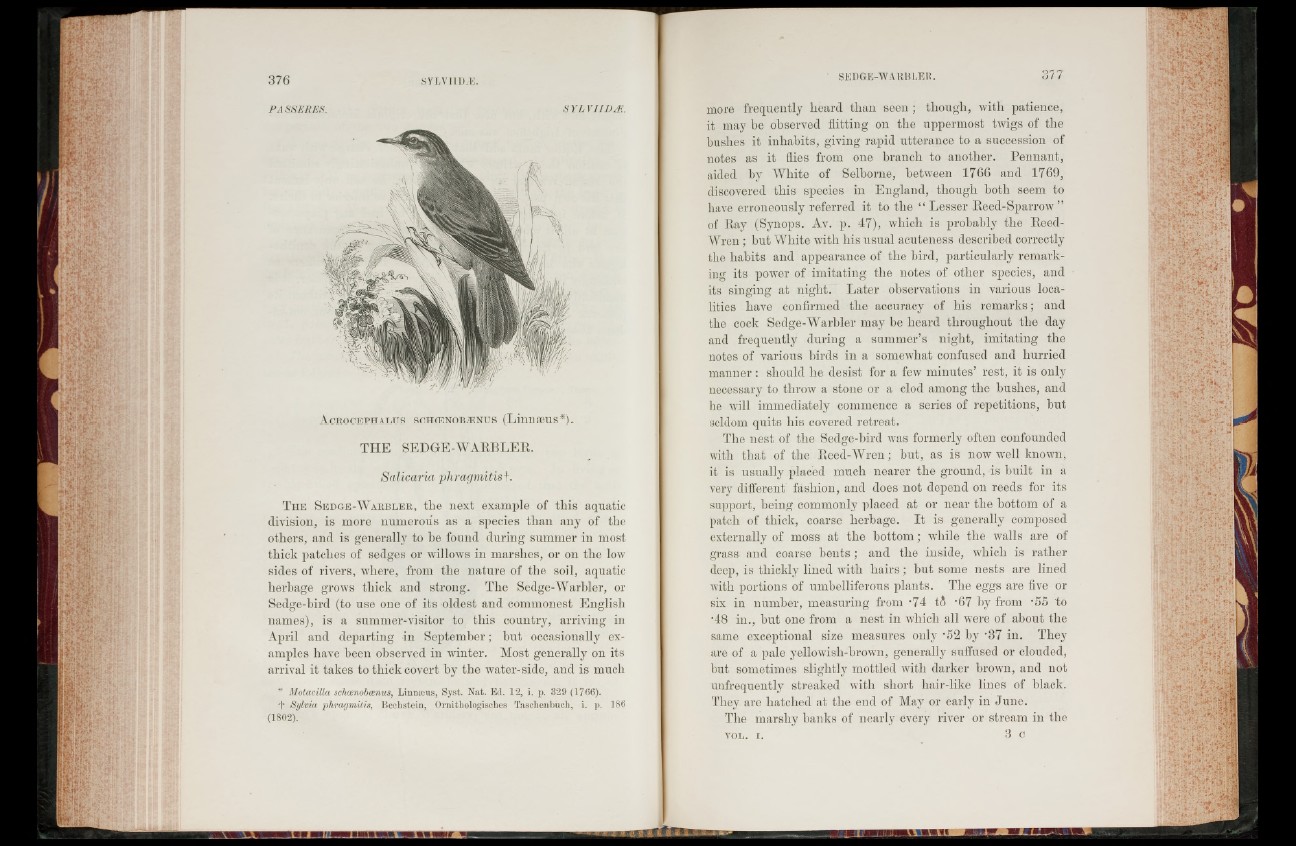
PA SSERES. S Y L V I [DM.
I
II
I -V • ,
A c r o c e p h a l u s s c h c e n o b ^ n u s (Linnasus*).
THE SEDGE-WARBLER.
Salicaria pliragmitis t.
T h e S e d g e -W a r b l e r , the next example of this aquatic
division, is more numerous as a species than any of the
others, and is generally to be found during summer in most
thick patches of sedges or willows in marshes, or on the low
sides of rivers, where, from the nature of the soil, aquatic
herbage grows thick and strong. The Sedge-Warbler, or
Sedge-bird (to use one of its oldest and commonest English
names), is a summer-visitor to this country, arriving in
April and departing in September; but occasionally examples
have been observed in winter. Most generally on its
arrival it takes to thick covert by the water-side, and is much
* Motacilla schcenobcenus, LinniBUS, Syst. Nat. Ed. 12, i. p. 329 (1766).
f Sylvia phragmitis, Bechstein, Ornitbologisches Taschenbuch, i. p.
(1802).
186
more frequently heard than seen ; though, with patience,
it may be observed flitting on the uppermost twigs of the
bushes it inhabits, giving rapid utterance to a succession of
notes as it flies from one branch to another. Pennant,
aided by White of Selborne, between 1766 and 1769,
discovered this species in England, though both seem to
have erroneously referred it to the “ Lesser Reed-Sparrow ”
of Ray (Synops. Av. p. 47), which is probably the Reed-
Wren ; but White with his usual acuteness described correctly
the habits and appearance of the bird, particularly remarking
its power of imitating the notes of other species, and
its singing at night. Later observations in various localities
have confirmed the accuracy of his remarks; and
the cock Sedge-Warbler may be heard throughout the day
and frequently during a summer’s night, imitating the
notes of various birds in a somewhat confused and hurried
manner: should he desist for a few minutes’ rest, it is only
necessary to throw a stone or a clod among the bushes, and
he will immediately commence a series of repetitions, but
seldom quits his covered retreat.
The nest of the Sedge-bird was formerly often confounded
with that of the Reed-Wren; but, as is now well known,
it is usually placed much nearer the ground, is built in a
very different fashion, and does not depend on reeds for its
support, being commonly placed at or near the bottom of a
patch of thick, coarse herbage. I t is generally composed
externally of moss at the bottom; while the -walls are of
grass and coarse b en ts; and the inside, which is rather
deep, is thickly lined with h a irs ; but some nests are lined
with portions of umbelliferous plants. The eggs are five or
six in number, measuring from -74 tA '67 by from -55 to
•48 in., but one from a nest in which all were of about the
same exceptional size measures only '52 by -37 in. They
are of a pale yellowish-brown, generally suffused or clouded,
but sometimes slightly mottled with darker brown, and not
unfrequently streaked with short hair-like lines of black.
They are hatched at the end of May or early in June.
The marshy banks of nearly every river or stream in the
v o l . i . 3 o